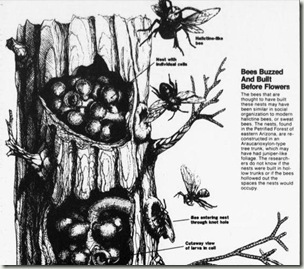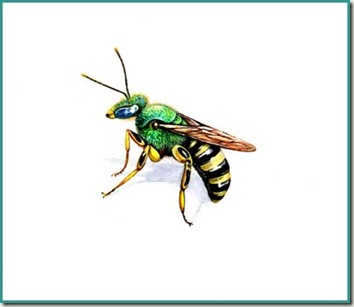The delightful and inquisitive little sweat bee, from the family Halictidae.
Known as sweat bees because some of them have shown an interest in the saltiness of human sweat, more usually the dark species than this green and striped one.
There are more than 1000 types of sweat bees and they come in black, brown, red or green/blue, metallic and striped.
I use the excellent Bugguide.net for much of my information.
The facts CLASS: Insecta
ORDER: Hymenoptera, Bees, wasps, ants and sawflies.
SUPERFAMILY: Apoidea. Bees and some wasps.
FAMILY: Halictidae (Sweat Bees)
GENUS: Agapostemon (Metallic Green Bees)
SPECIES: Agapostemon splendens
Agapostemon sweat bees are regarded as solitary bees.
Females dig burrows deep into the ground and fashion small cells which they supply with provisions of pollen and nectar. In each cell she lays an egg. Each burrow will contain several cells.
Some sweat bees though do seem to share nesting sites and so are thought to be in between the true solitary bees and the very social honey bees.
The correct term is “eusocial”.
Communal nesting is advantageous as while some bees are away looking for food the others can be defending the nest site.
The Halictid family is ancient and species have been found in amber dating back over 40 million years.
This little fossil Halictus petrefactus, from Spain, is approx 20 million years old, (from the American Museum of Natural History publication here.)
It is still a matter of debate as to when exactly bees evolved and which came first, bees or flowers.
Discoveries of bee nests in logs of the Petrified Forest in Arizona point to bees being in existence as far back as 220 million years ago, before the arrival of flowering plants, which upsets the theory that flowering plants and bees evolved together.
If so what did the bees live on ? The bee nests indicate that the species was very similar to the Halictids.
Read more about this fascinating topic in the New York Times article from 1995 here.
I haven’t yet found any more recent information.
My model for this small study was very much alive and well.
They are inquisitive, quick moving and alert little bees, and completely captivating to watch. I will be back to this bee to make a larger painting soon.
These studies are only 3.5 inches and I am looking forward to exploring this particular bee in more detail, if my eyesight holds out.
_______________________________________________________
Bee No 5 Agapostemon splendens









What a beautiful illustration. You've captured the iridescence of the thorax perfectly. I like all bees, and am very fond of these handsome little guys.
Thank you so much Helen . I am struggling a bit with the small size of these little studies but it's all very good practice. These bees are just fab.